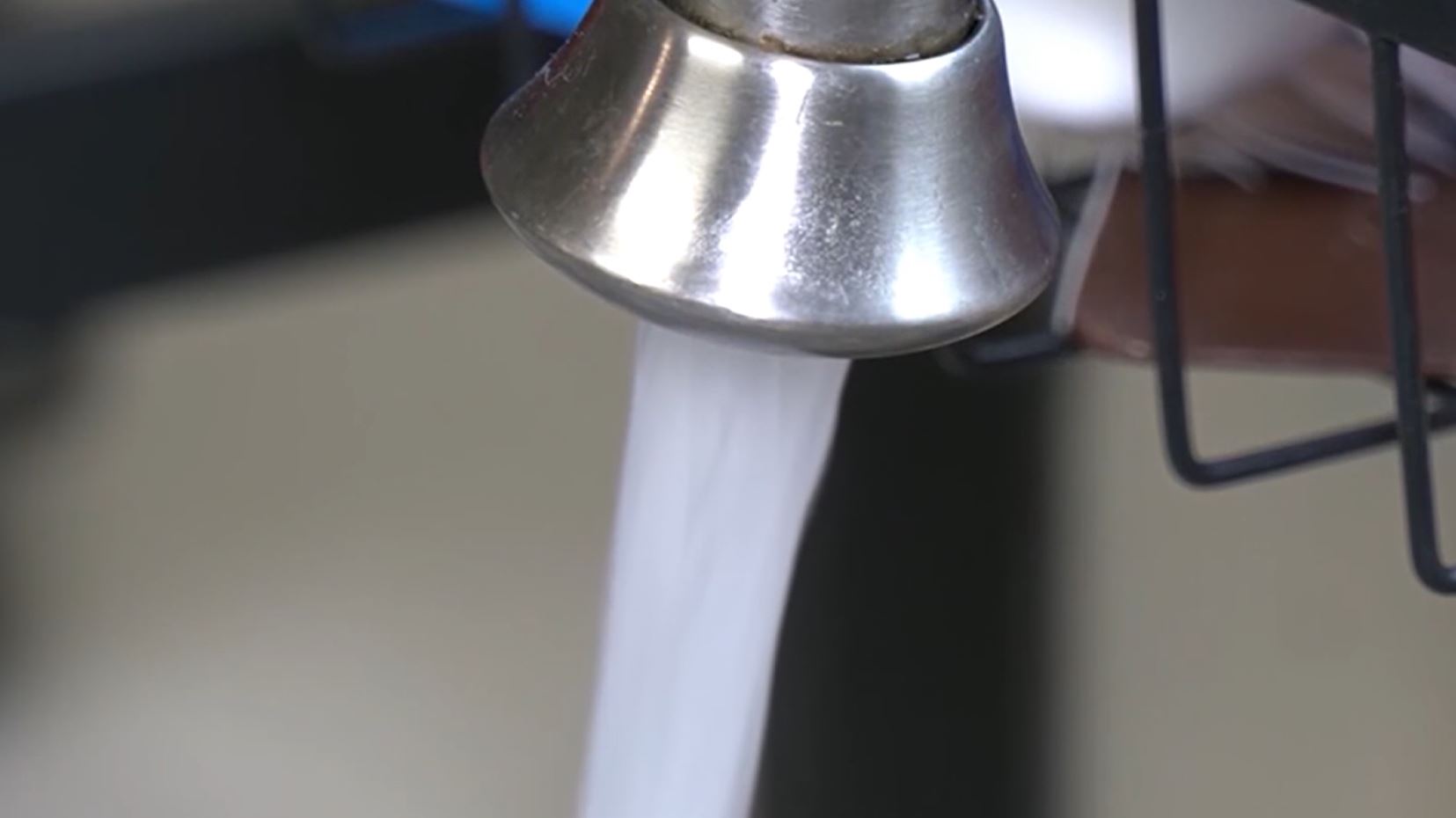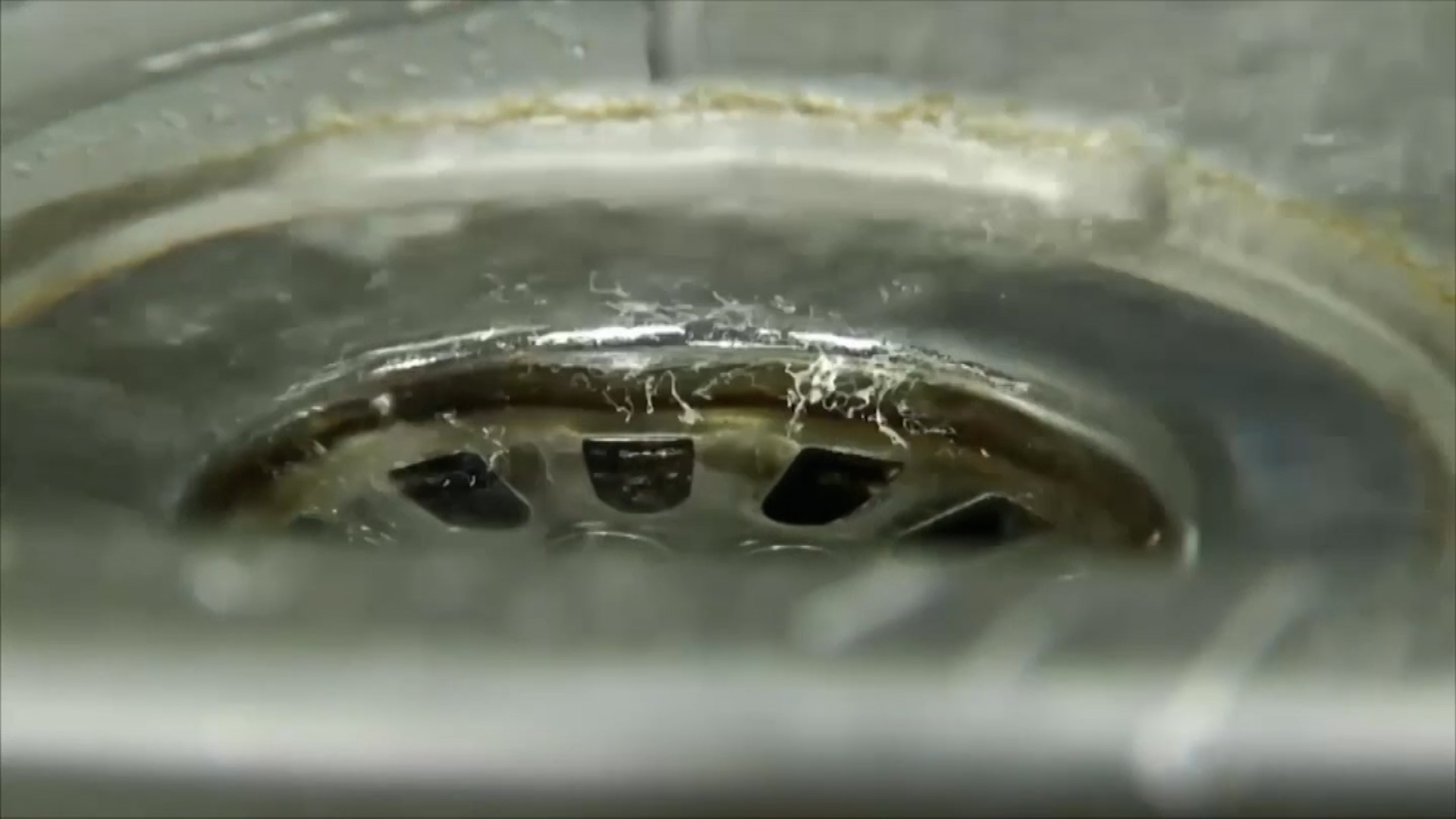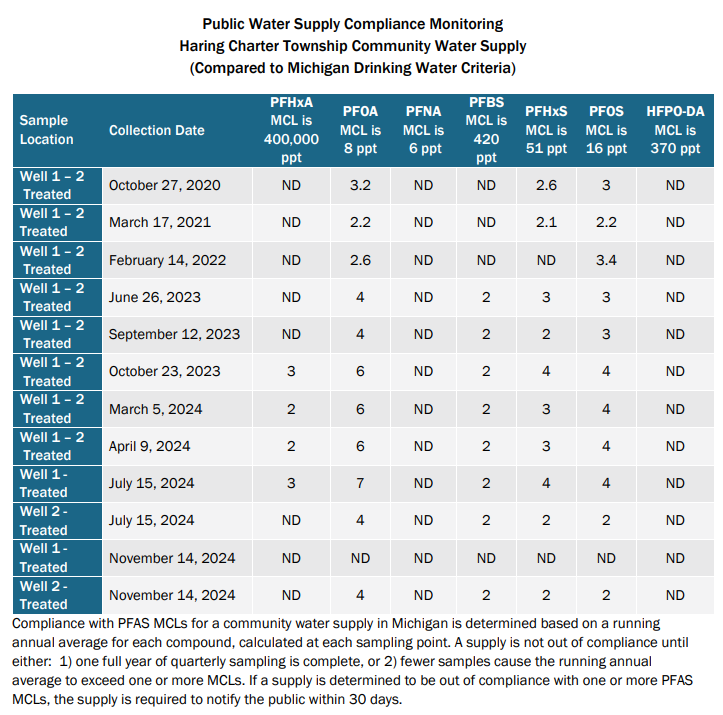As of the end of December 2024, the Michigan PFAS Action Response Team (MPART) has collected three rounds of private drinking water well samples, shared the results from the first two rounds and provided FAQ answers to the community.
However, many residents are still asking, “What’s the impact of PFAS in my area and solution(s)?” Below, explore the areas addressed in the report and get informed on what local leaders and state organizations are doing to address the contamination.
City of Cadillac

According to the report, the City of Cadillac’s drinking water has tested non-detect for all PFAS since it was first tested in 2018 and through the most recent sample in 2024. The city is on annual compliance monitoring for PFAS.
EGLE conducted a statewide sampling of community public water supplies from 2018-2020. Before the survey, the US Environmental Protection Agency set a Lifetime Health Advisory level of 70 parts per trillion (ppt) for perfluorooctane sulfonate (PFOS) and perfluorooctanoic acid (PFOA) in drinking water. Since August 2020, community public water supplies have been tasked with sampling their supplies for PFAS and reporting their results to EGLE.
The city moved the municipal wells from the Cadillac Industrial Area to their current location following a report from an EGLE employee with the City of Cadillac from 2006-17 that verified that the city began plans to abandon the wellfield at 6th Avenue and 8th Street before 2011 because the wells were over 50 years old and because of the potential for contamination due to the industrial area.
Only one well had detections for trichloroethylene (TCE) during that time, but it was not used to provide water to residents, as it was on standby for emergency use but not used.
History of the Cadillac wells:
- 6th Ave./8th St. Wells:
- Well 1: Installed in the 1960s and inactive in 2012
- Wells 2-4: Installed in the 1960s and inactive in November 2022 due to two new wellfields being online
- Well 5: Installed in the 1960s. Well casing shattered, undermined the building and was taken out of service
- Well 6: Installed in the 1960s and inactive in 2013
- Well 7: Installed in the 1970s to replace well 5 and inactive in 1994 (had TCE detects and no longer fed the system but available for emergencies before 2012)
- Crosby Road Wells:
- Wells 8-10: Installed in July 2012, all still active
- 44 Road Wells:
- Wells 11-13: Installed in November 2022, all still active
All households in the PFAS investigation area that are sampled by MPART and whose wells have any detection of PFAS are offered point-of-use filters, typically installed under the kitchen sink, through a Michigan Department of Health and Human Services filter recommendation.

District Health Department No. 10 in Cadillac will coordinate with a certified plumber and the resident to have the filter installed free of charge.
Ingestion, or swallowing, is the primary exposure route of concern for PFAS exposure. This includes water used for drinking, cooking and making baby formula. The point-of-use filter is an effective interim mitigation tool for the primary exposure route of concern.
PFAS-reducing filters, like the ones offered by local health departments, have an NSF/ANSI 53 designation, which means they were shown in a laboratory to reduce total PFAS down to 20 ppt. To remain effective, filter cartridges need to be changed according to the manufacturer’s instructions. Depending on usage, this is typically about every six months.
Households who were recommended filters can obtain filter replacement cartridges from their local health department.
Haring Township
Table No. 1 summarizes the township’s water supply results. The township complies with Michigan Safe Drinking Water Act standards and Maximum Contaminant Levels (MCLs). Haring Township’s community water supply is currently on quarterly compliance monitoring for PFAS.

A permit was issued on Nov. 1, 2024, that will allow the township to begin going through the bid process for installing a water main to connect the Wexford-Missaukee Career Technical Center to the township’s water. The township is currently getting bids and will likely begin construction in the spring.
The township is installing new municipal water wells, with the test well approval letter issued by EGLE on April 15, 2024. The township has completed the initial site investigation and is constructing a proposed production well to serve as the primary water source for the community. As of December 2024, the test well has been non-detect for PFAS.
The township will conduct the required aquifer test, including a pump test and additional water quality monitoring.
The results of the test will be evaluated and then the township could submit for a permit to equip the well for production, likely to be done before the end of 2025. After the well is permitted by EGLE and approval to commence operations is granted, the township will be able to use the new well to supply water to the people served by the township’s water supply.
Wastewater plant testing
Both Cadillac WWTP and Haring Township WWTP participated in the IPP PFAS Initiative. Under the IPP PFAS Initiative, both WWTPs evaluated their industrial facilities and collection systems to identify potential sources of PFOS to the WWTP.
The City of Cadillac identified one industrial source of PFOS to the WWTP — the Wexford County landfill.
In a March 4, 2019, letter EGLE required the city to sample the discharge from the WWTP on a semi-annual basis and to work with the landfill to reduce and/or eliminate PFOS from the discharge of landfill.
The city ceased accepting the discharge from the landfill in the summer of 2019. Upon re-issuance of the city’s NPDES permit on Nov. 29, 2023, EGLE determined the city completed the requirements of the IPP PFAS Initiative.

Haring Township did not identify any potential sources of PFOS. EGLE agreed with the Township’s assessment and in a letter sent to the Township on Sept. 27, 2018, determined the Township had completed the requirements of the IPP PFAS Initiative.
NPDES permit requires Cadillac WWTP and Haring Township WWTP to sample final effluent prior to discharging to the Clam River for PFAS at a frequency of three times per year (January, May and September).
Both WWTPs are required to submit the results of the PFAS sampling to EGLE and are accessible to the public via the MiEnviro Portal. View the full documents at the links below:
The discharge from both WWTPs has been in compliance with EGLE’s Rule 57 Water Quality Values for PFOS, PFOA, PFBS, PFNA and PFHxS since they began monitoring for PFAS in 2019.
According to the EGLE Addressing PFAS from Public and Private Municipal Groundwater Discharges Compliance Strategy report, WWTPs will be prioritized into one of three categories:
- Category 1 (High) – Concentrations in groundwater above Part 201 criteria, elevated concentrations in influent and/or effluent, high flows, known source(s) identified, downgradient receptors present or impacted, and/or potential to migrate off-site readily.
- Category 2 (Medium) – Concentrations in groundwater above Part 201 criteria, lower concentrations in influent and/or effluent, medium to lower flows, potential sources identified, and/or no immediate downgradient receptors, but potential to migrate off-site readily.
- Category 3 (Low) – Concentrations in groundwater below Part 201 criteria, lower concentrations in influent and/or effluent, lower flows, downgradient receptors not present, and/or low likelihood of off-site migration.
WRD EPS will also conduct PFAS sampling at a limited number of public and private municipal WWTPs with Part 22 Groundwater Discharge permits on a yearly basis. WRD’s initial goal is to sample 5-10 WWTPs per year.
WRD EPS will use the following prioritization scheme to select a limited number of WWTPs for PFAS sampling each year:
- Priority No. 1 – Public municipal WWTPs with an Industrial Pretreatment Program (IPP), and/or public and private municipal WWTPs with known sources of PFAS, known groundwater contamination of any chemical associated with the discharge (e.g., sodium, chloride, nitrate), known or potential impacts to downgradient drinking water wells, and/or previous PFAS results from any environmental media (e.g., soil, stormwater, biosolids) above applicable criteria, including MPART sites.
- Priority No. 2 – Public and private municipal WWTPs that accept landfill leachate, septage, and/or other high-strength waste (regardless of permit category), and/or have a 2218 Groundwater Discharge permit with an average daily flow greater than 0.5 million gallons per day (MGD).
- Priority No. 3 – Public and private municipal WWTPs with a 2218 Groundwater Discharge permit with an average daily flow of less than 0.5 million gallons per day (MGD).
- Priority No. 4 – Public and private municipal WWTPs with a non-2218 Groundwater Discharge permit.
Within each priority, sites will be further prioritized on a site-by-site basis and include unique conditions that may lead to a greater potential to impact groundwater and/or public health such as: downgradient receptors; unlined or leaky lagoons; lagoons with undetermined integrity; sludge management and/or storage issues; or discharge management issues.
Per the report, the aim is to ensure all discharges meet the required standards, though progress might be gradual depending on specific situations. As the WRD gains insight into the presence of PFAS in groundwater discharges and receiving waters, alternative wastewater disposal methods might need to be explored. Examining treatment options is also a key focus.
Read the full report about the plans for the WWTP.
Lake Cadillac & Lake Mitchell
In 2022, EGLE collected samples from Lake Mitchell, Lake Cadillac and at two locations in the Clam River downstream of Lake Cadillac. All samples were well below water quality criteria. PFOS results were below the typical levels found in lakes throughout the state.

Some fish species from Lake Cadillac and Lake Mitchell have been tested for PFAS. MDHHS is reviewing those results and will include updated fish consumption guidelines in the 2025 Eat Safe Fish Guide for Northwest Michigan. Currently, all fish consumption guidelines for these two lakes are due to mercury, as published in the 2023 Eat Safe Fish Guide – Northwest Michigan.



